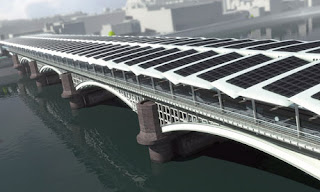The first bridge was opened in
1864 and was designed by Joseph Cubitt for the London, Chatham and Dover
Railway. Massive abutments at each end carried the railway’s insignia, preserved and restored on the south side.
Following the formation of the Southern Railway in 1924, inter-city and
continental services were concentrated on Waterloo, and St Paul’s Station
became a local and suburban stop. For this reason, the use of the original
bridge gradually declined.
It eventually became too weak to
support modern trains, and was therefore removed in 1985 – all that remains is
a series of columns crossing the Thames and the southern abutment, which is a
Grade II listed structure.
The second bridge, built slightly
further downstream (to the east), was originally called St Paul’s Railway
Bridge and opened in 1886. It was designed by John Wolfe-Barry and Henry Marc
Brunel and is made of wrought iron. It was built by Lucas & Aird. When St
Paul’s railway station changed its name to Blackfriars in 1937 the bridge name changed
as well.
Work on the new refurbishment
initially started back in Spring 2010 when Balfour Beatty set about creating
the foundation work on the bridge. Following the refurbishment and a
multi-million pound refit, which includes extending the platform, partially
supported by the 1864 bridge piers, Blackfriars bridge will be the first
station in London to span the Thames. But it’s not just the first station to
span the Thames, there are also a number of other first’s that the bridge will
take.
Now nearing completion, the
Victorian bridge will play host to some 6,000 square metres of photovoltaic
(PV) panels, making it London’s largest solar array. Further green initiatives
include the installation of 200mm BLÜCHER® EuroPipe as part of the rain harvesting
systems, all of which will significantly contribute to Network Rail’s plans
to reduce carbon emissions by 25 per cent per passenger kilometre by 2020.
For BLÜCHER UK Ltd the bridge was
the first project where its new range of stainless steel rainwater outlets for
Siphonic and gravity systems were installed. It also featured BLÜCHER® EuroPipe
for vacuum, siphonic and gravity applications. A testament to the flexibility of
the stainless steel push fit pipework system.
Terry Thorne of Thorne Rainwater
Systems who are one of the UK leaders in siphonic roof drainage systems commented:
“
This was a prestigious project for Thorne. We found BLÜCHER® EuroPipe offered
the performance and durability of a traditional metallic system with the light
weight and ease of installation associated with push fit systems. The close
working relationship between Thorne, Balfour Beatty and Blucher was a key
factor in ensuring a timely delivery of the project..”
Lindsay Vamplew, Network Rail’s
project director for Blackfriars, said
“the
refurbishment will make the station a template for green stations around the
world”.
Due for completion soon, the new Blackfriars station
will capable of dealing with three times as many trains and passengers as it did
before refurbishment.


No comments:
Post a Comment